You are here
Ancient settlement Kok Mardan.
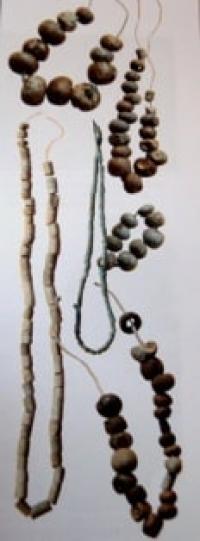
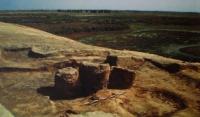

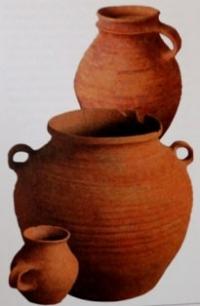
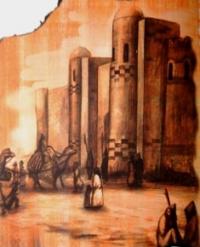

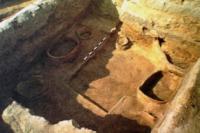
Ancient fortifications on Silk Road of Kazakhstan.
"Where once raging,
The multitudes were flowing
Hordes and kingdoms forming
According to the hollows of the earth"
Maximilian Voloshin. Koktebel. November 19, 1919.
Travel style – group individual tours Turkestan.
The Kok Mardan (Kokmardan) settlement is located on a natural hill 214 meters above sea level, 3.4 kilometers west of the left (western) bank of the Arys River, 8 kilometers east of the right (eastern) bank of the Syr Darya River, 5.6 kilometers south-west of the village of Shaulder, 9.7 kilometers south-east of the village of Kogam in the Otrar district of the Turkestan region.
The ancient settlement Kok Mardan belongs to the monuments of the Otrar oasis. This is one of the largest hills or mounds located on the left bank of Arys. The remains of dozens of mounds of various sizes are here as silent witnesses of a life that has gone into the past. Pshuk-Mardan, Kostobe, Chashtobe, Seytmantobe, Akhaytobe, Choltobe, all of them are geographically attached to the ancient, once full-flowing, and now dried up channels of Arys.
The ruins of Kok Mardan consist of two parts: the main hillock and the hills next to it. This is the central part of the fortress; it occupies the confluence of two ancient channels of Arys. Entrance to the city led along an artificial dam, which turned into a gentle slope leading up to the gate.
The entrance was protected by two round-shaped towers. Judging by the size and position, Kok Mardan was at one time a peculiar center of the settled life of an agricultural oasis. Excavations showed that this is a multi-layered settlement, consisting of several towns of different times, successively replacing each other.
The highest urban layout was identified only in small areas, as the dwellings were washed out by rains, scattered by the wind and almost not preserved. In addition, it was noticed that the city in the late period of its life was in decline: its buildings were dilapidated and gradually abandoned.
Life slowly faded away. Finally, the last inhabitants went to another place, taking all the most valuable. What caused the death of the town is not yet clear. This could be a change in the Arys channel, which caused the drying of the river’s channels and, consequently, “water hunger” among the residents of Kok Mardan, forced to look for new sources.
Perhaps environmental factors also played a role, for example, salinization of soils in the agricultural land zone, which could also cause the decline of Kuik Mardan and other settlements of the tract. And the earlier town below was made up of residential buildings, separated by main streets and alleys.
Houses, as a rule, are one-room, less often two-room, and one of the rooms was usually reserved for a pantry. You can judge how the one-room house looked. All houses were buried somewhat in the ground, so from the streets they led from three to five steps.
Opposite the entrance, closer to the center, a hearth was set up on the floor - a rectangular recess in the floor with adobe sides along the edge. In each house near the hearth, grain mills were found to grind grains into flour.
Sometimes there were special devices being built in the houses for millstones. The lower half - “sunbeds” - was smeared into a low rounded curbstone. In one of the walls of the house, at the floor level or slightly higher, an oval niche for the fireplace was necessarily hollowed out, on the bottom of which an earthenware fryer was placed.
Sufas were arranged along the perimeter of the room near the walls - couches up to a meter wide. In the corners of the premises are niches in front of which a slight elevation was made, where, judging by the layer of ash, a ritual fire was lit.
At the corners there were vessels for water and food - usually they were aquifer jugs, two-handed pots. In the pantry were humas or barrel-shaped vessels in the form of cylindrical containers, in which, as it turned out, they stored millet, rice, wheat, barley, and peas.
One of the one-room houses differed from the others in a small construction. Opposite the entrance to the wall at the height of half a meter was a niche of rectangular shape, framed along the edge in the form of ram horns.
A two-stage elevation - a podium reaching a niche, a small compartment on the right, separated by a wall, clay lamps found during excavations on the floor, a layer of clean ash on the podium - all this is undoubted evidence of the presence in the house of a sanctuary with an altar associated with the cult of fire.
All buildings of Kok Mardan are built of rectangular raw brick. The walls were built without foundation, their foundations were placed directly on the ground. Inside, they were repeatedly coated with clay. The ceilings were flat, resting on wooden beams supported by supporting pillars also made of wood.
Usually there were four such pillars - this is evidenced by the rectangular nests from the supports (bases) preserved in the floor of the houses. The roof was a thick layer of reeds laid on beams and coated on top with a layer of clay mixed with ash.
It was possible to establish this during excavations: on the floor of some rooms, archaeologists found pieces with prints of reed stems. Findings of cereal grains, the presence of grain pits, straw on the floor and in raw brick, discovered grain grinders and hums for storing grain reserves, stone hoes, bone agricultural implements - all this indicates the development of agriculture here.
Undoubtedly, it was irrigated, although irrigation techniques were simple. An important industry was cattle breeding. We learn about this from a large number of bones of domestic animals: horses, sheep, goats, cattle. In the life of the settlers, hunting played a large role.
During the excavation, roe bones, mountain goat, argali, saigas were found. Often there are argali and maral horns, which were used for the manufacture of various products. Residents hunted waterfowl: ducks, geese, pelicans, fished, as evidenced by finds of fish bones and scales, using harpoons, various fishing tackle.
Near the towns and villages there were cemeteries. Unusual funerary structures were found on the Kok Mardan necropolis - artificial clay platforms up to 3 m high and 15 m in diameter. Graves in which the dead were buried were cut down in the platform.
Moreover, there is a pattern in which the richest burials were located in the corners, and the children occupied the periphery. All this construction was a kind of collective tomb. One to five to seven dead are usually buried in a grave.
It was customary to place various objects talking about a certain ritual near the buried. These are dishes with food and water, weapons and various decorations. Weapons served as iron three-bladed arrowheads, a complex bow with bone plates, long iron swords and daggers.
In the graves of Kok Mardan, many buckles of iron and bronze were found, which once fastened leather belts. Among the jewelry there are women’s: stone, metal, glass beads; earrings and pendants with inserts of colored stones, with clusters of bronze or gold balls; a necklace woven from wire drills; hairpins.
In the women's graves there were bronze mirrors, and surrogates - objects from graphite for blackening eyebrows. One of the finds is a bronze medallion decorated with transparent glass inserts and a bronze chain. These objects are depicted below in the form in which they were found in the burial: a broken chain, parts destroyed from time to time.
The symmetrical pattern on the medallion and the curly leaves framing it are noteworthy. Most of the burials were looted in antiquity. But preserved and not disturbed burials, among which there are rich, with lots of jewelry, weapons, clay vessels.
In the graves of the poor there are fewer things and no products made of precious metals. In children's burials, as a rule, one or two clay vessels are found. Characteristic of the graves of Kok Mardan is the presence of various amulets, pendants, among which many bronze figures of goats, other animals and birds.
There are beads from carnelian, agate, rock crystal, glass, glassy paste. Interesting are plaques from belts, belt buckles, as well as gold products: earrings with pendants in the form of clusters of balls, plaques decorated with inserts of colored stones, woven chains.
All these finds serve as objects for deep study of the culture of a people that lived many centuries ago. It was established that among the inhabitants of Kok Mardan there were many artisans who knew how to melt iron and make sickles, knives, and arrowheads from it.
Round blanks of iron were found from which the blacksmiths forged these items. Products of artisan-bone carvers are diverse: these are overlays for compound bows, and knife handles, and pins, and fasteners. Interesting, for example, amulets from the phalanges of a wolf, an eagle, a dog.
When dealing with amulets, people believed that certain qualities of animals and birds were transferred to them. Original long bone-shaped pins with curly heads are original: apparently, the pins served to secure the hairstyle.
Geographic coordinates of Kok Mardan settlement: N42°44'49,59" E68°19'28,64"
Authority:
"The medieval cities of Kazakhstan on the Great Silk Road" K.M. Baipakov, Almaty, Gylym, 1998, 216 p.







